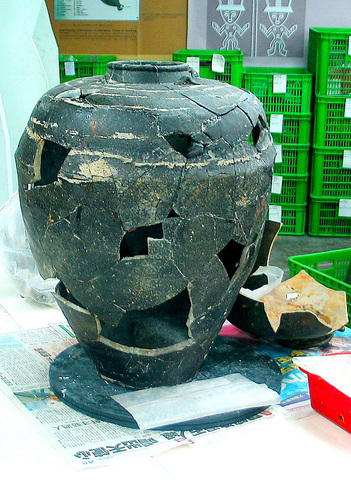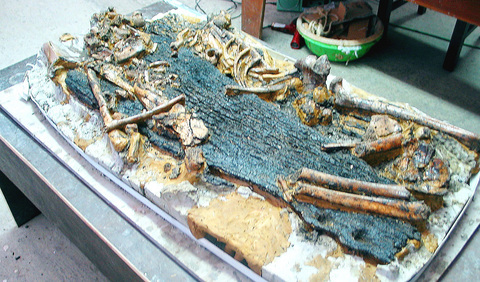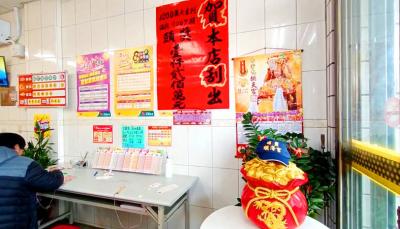An archaeological excavation project in Ilan County at an expressway construction site successfully demonstrates the harmonious co-existence of economic development and cultural preservation, according to experts.
In the research offices and labs of the Ilan County Cultural Bureau, tens of thousands of pieces of Kavalan cultural remains found at the Kibannoran historic site (淇武蘭遺址) in Chiaohsi Township are waiting to be pieced together and studied.

PHOTO: CHIU YU-TZU, TAIPEI TIMES
Chiaohsi, which sits beside sea volcanoes, is well known for its murmuring hot springs and beautiful environment.

PHOTO: CHIU YU-TZU, TAIPEI TIMES
However, the existing winding roadways tourists must use to travel to the area from metropolitan Taipei have long been regarded as one of the major obstacles hampering development in the rural county.
In 1994, the Ministry of Transportation and Communications (MOTC) launched the Taipei-Ilan Expressway project, hoping to shorten the hour-long drive between Taipei City and Ilan to only 25 minutes by 2007.
Close Proximity
The Environmental Impact Assessment (EIA) for the development project was passed early on with a "conditional" rating. The route's proximity to several sites in Chiaohsi containing Kavalan cultural artifacts had already been confirmed, and many researchers were worried about the impact of the construction project on such sites.
Therefore, the EIA committee required up-to-date and regular reviews of the progress being made with historic sites in Chiaohsi from the MOTC during the construction project's evaluation process.
In June 2001, numerous animal and human remains, as well as pieces of pottery and houses, were inadvertently found by engineers, who were working near an estuary of the township's Tetzekou River. After spending five months investigating the site, the Ilan County Government officially carried out an archaeological excavation project with anthropologists from National Taiwan University.
In July 2002, construction of the expressway was suspended after researchers confirmed that the proposed route passed directly through the historic site. Since then, the MOTC not only re-evaluated the situation, but also teamed up with researchers to salvage cultural remains dating from as early as 800 AD.
According to the Ilan County Cultural Bureau, there have been two different cultural sites uncovered at different levels in the strata of the site since the excavation project was launched in late 2001.
In the upper layer, which is only 20cm to 30cm beneath sea level, pottery and other artifacts produced by the Kavalan Aboriginal people about 300 years ago were found.
"[The Kavalan Aborigines] really excelled at making pottery. The thickness of the pieces, on which elegant geometric patterns can be observed, ranges from a mere 0.1cm to 0.5cm," said Chiou Shiou-lan (
In the upper layer, 125 burial sites have also been found.
According to a survey in 1648 by the Dutch -- who colonized parts of Taiwan in the 17th century -- among the 39 villages on the Lanyang plain at the time, Kibannoran was the largest one, and was home to about 840 Kavalan Aboriginal people from 160 families.
Success
So far, researchers have investigated an area covering 3,750m2, where 262 excavation pits are located. More than 200,000 Kavalan cultural artifacts -- including more than 30 kinds of seashells (indicating a thriving maritime culture), stone instruments, metal ornaments, wooden carvings and other items -- have been salvaged from the site and are being held by the bureau and National Taiwan University. The project has been regarded as the most successful excavation site on the plain. It has also contributed a lot to the study of Kavalan culture.
After piecing together pottery urns and other instruments, researchers uncovered evidence that Kavalan Aborigines traded regularly with foreign merchantman from Europe and throughout Asia, including Japan and the East Indies.
Chiou Shei-jin (
"If you look at the tobacco pipes made by the Kavalan people, you will find that the shapes and curvature patterns resemble certain European artifacts," Chiou Shei-jin said.
As for the second cultural layer, which was located 1.2m to 1.5m below sea level, researchers said that it could be related to another tribe that arrived in the Lanyang plain about 1,000 years ago.
Researchers said the site was very muddy 2,600 years ago. It became a swamp about 2,000 years ago and eventually became dry land about 1,500 years ago. It was estimated that people did not arrive at the site until 1,300 years ago.
By investigating remains, researchers suspect that because of devastating floods about 800 years ago, the people who had been living at the site broke into several groups, which moved to other places.
About 400 years ago, the Kavalan Aboriginal people arrived at the site, beginning the most recent human development of the plain.
According to researchers, the Kibannoran historic site belongs to the age metal-and-stone tools, which is represented by the Shihsanhang Culture (十三行文化).
Future findings from studies at the site will be crucial to revealing the cultural attributes, tribal migration patterns and other characteristics of the people who lived on the Lanyang Plain.
In March, Ilan County Government will hold a cultural expo, through which artifacts found at the Kibannoran historic site will be systematically displayed to residents interested in Taiwan's history.
Environmental Protection Administrator Chang Juu-en (
Tzou Tsann-yang (
Other Interest
In addition to the cultural aspects of the site, ecological researchers have also taken note of the project. The Academia Sinica's Institute of Zoology has found that ecological systems on the plain varied dramatically, because wild oysters were extraordinarily large compared to other records. In addition, the mangroves in coastal areas which flourished long ago are missing.
Nowadays, the archaeological excavation project continues. Because of the difficulties in finding a place to use as a cultural museum, the artifacts will continue being held by researchers.
"So far we can only dig out artifacts from sites which are scheduled to be destroyed by development projects. Certainly, from the artifacts we have found, we and future generations can learn a lot about how their ancient ancestors lived on this land," Chiou Shei-jin said.

Global bodies should stop excluding Taiwan for political reasons, President William Lai (賴清德) told Pope Francis in a letter, adding that he agrees war has no winners. The Vatican is one of only 12 countries to retain formal diplomatic ties with Taiwan, and Taipei has watched with concern efforts by Beijing and the Holy See to improve ties. In October, the Vatican and China extended an accord on the appointment of Catholic bishops in China for four years, pointing to a new level of trust between the two parties. Lai, writing to the pope in response to the pontiff’s message on Jan. 1’s

A Vietnamese migrant worker on Thursday won the NT$12 million (US$383,590) jackpot on a scratch-off lottery ticket she bought from a lottery shop in Changhua County’s Puyan Township (埔鹽), Taiwan Lottery Co said yesterday. The lottery winner, who is in her 30s and married, said she would continue to work in Taiwan and send her winnings to her family in Vietnam to improve their life. More Taiwanese and migrant workers have flocked to the lottery shop on Sec 2 of Jhangshuei Road (彰水路) to share in the luck. The shop owner, surnamed Chen (陳), said that his shop has been open for just

TAKE BREAKS: A woman developed cystitis by refusing to get up to use the bathroom while playing mahjong for fear of disturbing her winning streak, a doctor said People should stand up and move around often while traveling or playing mahjong during the Lunar New Year holiday, as prolonged sitting can lead to cystitis or hemorrhoids, doctors said. Yuan’s General Hospital urologist Lee Tsung-hsi (李宗熹) said that he treated a 63-year-old woman surnamed Chao (趙) who had been sitting motionless and holding off going to the bathroom, increasing her risk of bladder infection. Chao would drink beverages and not urinate for several hours while playing mahjong with friends and family, especially when she was on a winning streak, afraid that using the bathroom would ruin her luck, he said. She had

MUST REMAIN FREE: A Chinese takeover of Taiwan would lead to a global conflict, and if the nation blows up, the world’s factories would fall in a week, a minister said Taiwan is like Prague in 1938 facing Adolf Hitler; only if Taiwan remains free and democratic would the world be safe, Deputy Minister of Foreign Affairs Francois Wu (吳志中) said in an interview with Italian newspaper Corriere della Sera. The ministry on Saturday said Corriere della Sera is one of Italy’s oldest and most read newspapers, frequently covers European economic and political issues, and that Wu agreed to an interview with the paper’s senior political analyst Massimo Franco in Taipei on Jan. 3. The interview was published on Jan. 26 with the title “Taiwan like Prague in 1938 with Hitler,” the ministry